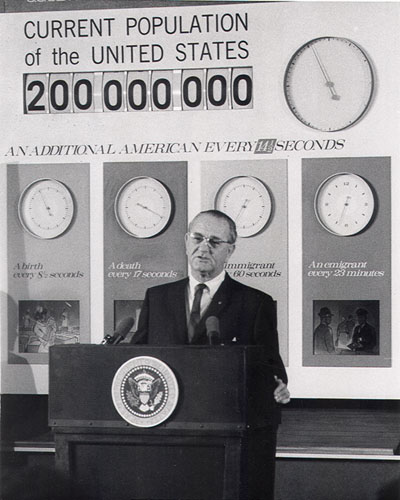History
History
Browse our narrative and historical materials for each of the 22 decennial (ten year) censuses, information and artifacts about the Census Bureau itself, its programs, and its technical achievements. Here you'll find historical information about the many aspects of census taking in the United States, including:
- The 1850 census was the first to list the names of all people in each household on the questionnaire. Read more about historical censuses.
- President Theodore Roosevelt signed legislation creating a permanent Census Bureau in 1902. Read more about the history of the U.S. Census Bureau.
- The Census Bureau's 1937 special census of unemployment was the first survey to use probability sampling techniques. Read more about the history of demographic programs.

Featured Photograph
On November 20, 1967, President Lyndon B. Johnson announced that according to the census clock, the nation's population reached the 200 million mark. Approximately 39 years later, on October 17, 2006, the census clock reached its latest population milestone of 300 million.
Contact Us
Questions or comments? Email the History Staff.
Tips for Genealogists
Interested in researching your family genealogy? Check out our tips for amateur genealogists.
This Month in Census History
In October 1953, the Secretary of Commerce asked Dr. Ralph J. Watkins to study the nation's need for the economic census following cancellation of the 1953 enumeration. The February 1954 Watkins Commission report, "Appraisal of Census Programs," led to the reinstatement of the economic census in 1954 and subsequent censuses.
Did you Know?
The Census Bureau accepted delivery of UNIVAC, the first electronic computer used by a civilian government agency on March 31, 1951.